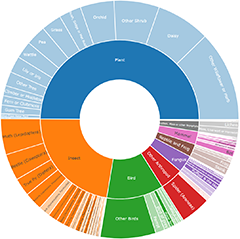Beetles (Coleoptera)
Announcements
There are currently no announcements.
Discussion
MarkH
wrote:
2 hrs ago
It’s definitely a Buprestid and , being on Dillwynia, is likely to be either a Melobasis, Diphucrania or Ethonion. I would lean towards a Diphucrania at this stage however without better pictures it may have to remain a mystery
Buprestidae sp. (family)
entom2
wrote:
1 Oct 2025
Given the disparity of specimens which are patently different species attributed in iNat etc to this species, the disjunct distributions of their known populations (which may be a function of localised collecting effort), and importantly the lack of a comprehensive modern revision (requiring careful comparison with types), I would not be surprised if maculate-patterned species such as this prove to comprise several species. Let's hope that some competent person (or persons) will engage in the long-overdue revision of this interesting genus sooner than later. Cheers, Allen M. Sundholm.
Ethonion reichei
Significant sightings
- Paropsis pantherina at Broke, NSW
- Australoneda bourgeoisi at Nimbin, NSW
- Aporocera rufescens at Rendezvous Creek, ACT
- Araiorrhinus howittii at Melba, ACT
- Atesta chiangi at Melba, ACT
- Chlorobapta bestii at Oallen, NSW
- Paraschizognathus elgatus at Falls Creek, VIC
- Temognatha thoracica at Cook, ACT
- Tragocerus spencii at Wyanbene, NSW
- Aporocera (Aporocera) iridipennis at Vincentia, NSW
Top contributors
- AlisonMilton 2.7K
- Hejor1 1.9K
- Harrisi 1.8K
- kasiaaus 1.1K
- trevorpreston 1.1K
- ConBoekel 829
- clarehoneydove 780
- CathB 600
- jb2602 553
- MichaelBedingfield 475
Top moderators
- AlisonMilton 8.6K
- MichaelMulvaney 4.5K
- KimberiRP 2.6K
- KimPullen 2.2K
- MichaelBedingfield 1K
- Harrisi 846
- Amata 846
- DiBickers 484
- MarkH 271
- HaukeKoch 251







































































































